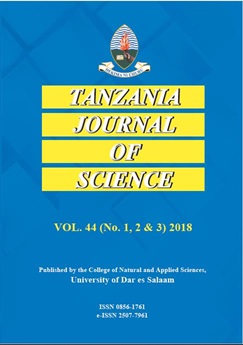Fluoride occurrence in domestic water supply sources in Tanzania: a case of Meru district Arusha region
Abstract
water in rivers and ground water shallow and deep wells and springs for house hold activities. The presence of fluoride in high concentrations in drinking water or cooking water causes severe health problems to the people. Distribution of fluoride concentrations in Meru district domestic water sources was studied by referencing the location of water sources using Extrex 20 garmin hand held GPS instrument. Fluoride concentrations were measured using Metrohm Ag/AgCl reference electrode connected to a Metrohm potentiometer (826 pH/Ion Meter) in a laboratory. Fluoride concentrations were found to range between 0.76 and 1103 mg/L. Around 69% of 146 samples collected had fluoride concentrations above 1.5 mg/L which is the WHO recommended standard while 47% of the samples had fluoride concentrations exceeding 4.0 mg/L as recommended by the Tanzania Bureau of Standards. The results indicate that, residences in five wards of Meru district namely Kikatiti, King ' ori, Leguruki, Maji ya Chai, and Ngarenanyuki are exposed to high levels of fluoride posing risk of dental and skeletal fluorosis. Generally, the study observed that most of the ground and surface water resources in Meru district are contaminated with high fluoride concentration and therefore waters from most sources in the areas (wards) need to be defluoridated to be potable.
Keywords: Dental fluorosis, Ground water fluoride, Skeletal fluorosis, Fluoride distribution map, Surface water fluoride


